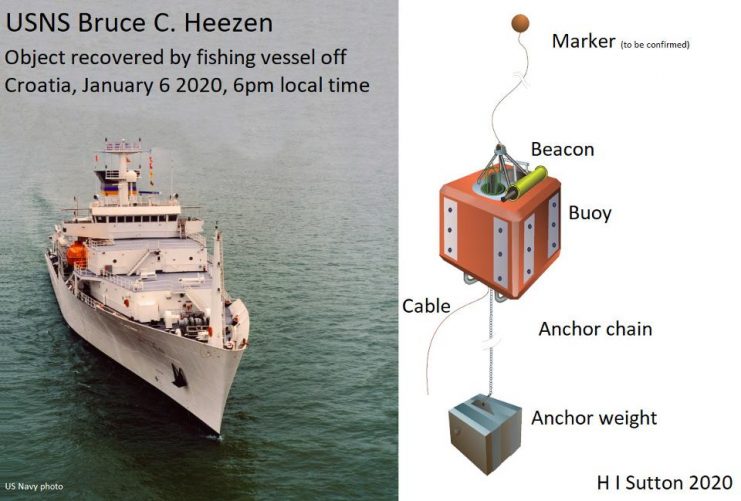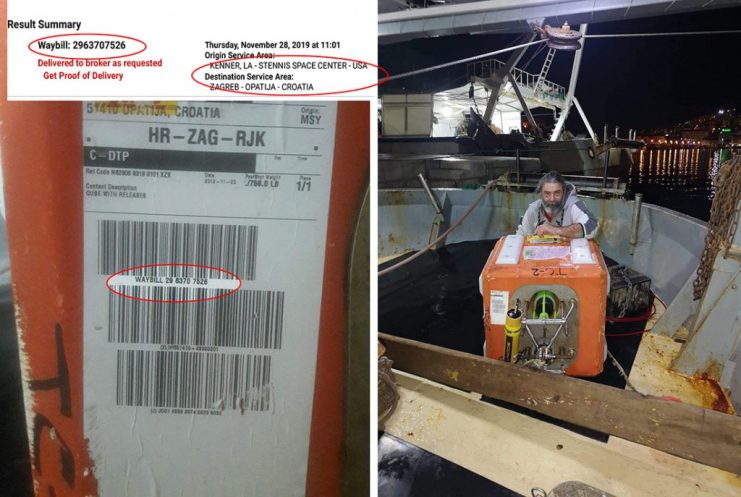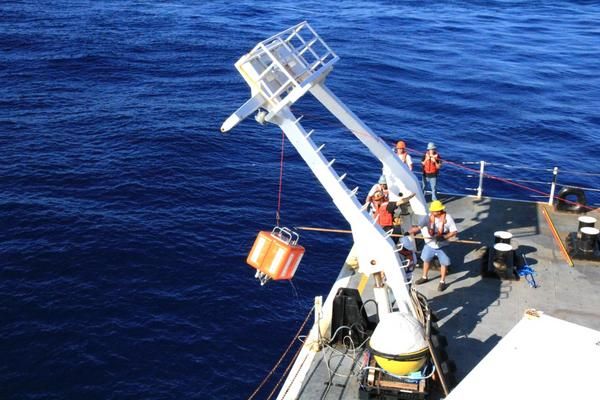The gathering of intelligence has always been a crucial factor in warfare, but now we have confirmation that the US Navy has taken listening in to a whole new level.
In WWII slogans such as ‘Careless Talk Costs Lives’ and ‘Walls Have Ears’ reminded the population that spies could be listening in on conversations and gleaning valuable information unintentionally divulged.
Fishermen in the Adriatic Sea, between Italy and the Balkan States of Croatia and Montenegro, have recently netted a US Navy EARS underwater recording device.

Croatian fisherman Darko Kunac Bigava from Podgora was fishing as usual between the islands of Mljet and Sveti Andrija, when he suddenly caught a mysterious orange device in his fishing net.
The Croatian crew of the Marian II were trawling in shallow waters when they brought the 220-pound device to the surface.

Not knowing what they had caught the fishermen took to social media in order to solicit identification. The images found their way into the hands of the US Navy who contacted the ship’s operators and requested that the device be handed over.
The US Navy survey ship the Bruce C. Heezen took possession after damage to the fishing nets was paid for which cost the Navy $3000.
Interestingly, according to the DHL waybill number it looks like the object was sent from Stennis Space Center but who is on the receiving side?

The EARS system was developed to be an autonomous underwater recording system, moored in a particular place in order to monitor ambient sounds over the long term.
The Naval Oceanographic Office (NAVOCEANO) and the Littoral Acoustic Demonstration Centre (LADC) have been working together with US Navy and University scientists since 2001 in a project headlined to target both beaked and sperm whales.
#USNSMarySears EARS buoy recovery. pic.twitter.com/vsOwS45eOT
— NAVOCEANO (@NAVOCEANO_SSC) September 10, 2015
Experiments in the Gulf of Mexico have produced extraordinary records of sperm whale echolocation, coda clicks, and the sounds produced by other whales in the vicinity.
The clarity of the recordings made by the EARS system has meant that individual whales can be identified from the sound of the Odontocete clicks.
The system was deployed at a depth of 550m to 1000m in the Gulf of Mexico, whereas the one discovered in the Adriatic was in just 450m of water.
First generation models were capable of recording one channel while Gen 2 models were able to record on four. H I Sutton, a naval Open Source intelligence (OSINT) analyst, confirmed that the device discovered in the Adriatic Sea was a US Navy asset capable of recording undersea sounds for an entire year.
The bigger mystery for military-watchers is why would the US Navy be so interested in the underwater sonic environment present in such a non-contentious region?
EARS buoy is secured on deck of #USNSMarySears. pic.twitter.com/EzEXs84BFI
— NAVOCEANO (@NAVOCEANO_SSC) September 14, 2015
Monitoring of peaceful seas might enable the Navy to analyse changes to the norm thereby identifying sonic signatures of enemy submarine movements, or it may help to develop sonic camouflage for their own undersea fleet.
Submarine warfare is, and always has been, about stealth. Detection of enemy submarines is challenging, with a torpedo launch sometimes the first indication any surface-going vessel has that danger is lurking nearby.
Radar has its limits too with the design of military ships, planes and underwater craft being calculated to thwart detection.
The EARS system is built to rest on the seabed until a signal sets in motion an automatic un-tethering device that allows the equipment to float to the surface for retrieval by the survey ship.
The box-shaped buoy is known as a Qube, which is the first thing the Croatian fishermen recovered, attached to it is the sensor, which emits a coded signal.
This can, apparently, be set to silent mode, making the discovery of the device by foreign navies almost impossible.
Commentators have since had a field day speculating what such a listening device might be doing in the European Mediterranean region.
Is it for camouflage program research, or do we have reason to believe there might be other covert action in the area that the US Navy are interested in monitoring?
Found: USS Grayback, Final Resting Place of 80 Entombed Sailors
The US authorities have yet to comment beyond confirming that the deployment of EARS systems around the world is a normal part of routine NAVOCEANO activities.
